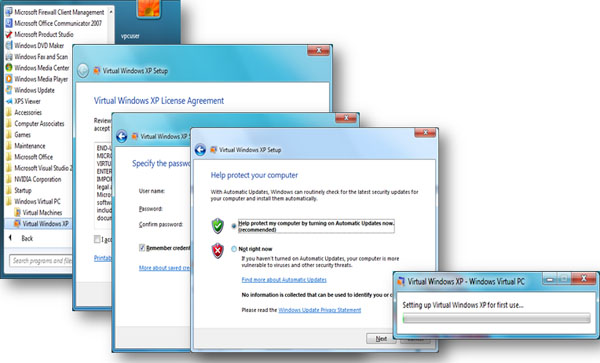

- #WINDOWS 7 VIRTUAL PC DIRECTORY FULL#
- #WINDOWS 7 VIRTUAL PC DIRECTORY SOFTWARE#
- #WINDOWS 7 VIRTUAL PC DIRECTORY WINDOWS 7#
- #WINDOWS 7 VIRTUAL PC DIRECTORY MAC#
#WINDOWS 7 VIRTUAL PC DIRECTORY FULL#
YOU MUST SUBMIT A FULL-SCREEN IMAGE FOR FULL CREDIT! That will copy the whole desktop to the clipboard. Press the PrintScrn key in the upper-right portion of the keyboard.
#WINDOWS 7 VIRTUAL PC DIRECTORY WINDOWS 7#
Note the hand symbol on the image above: that indicates screen images that you must capture and turn in.Ĭlick the taskbar at the bottom of your host Windows 7 desktop, to make the host machine listen to the keyboard, instead of the virtual machine. To do that, you need to capture an image of the screen and email it to me. The only thing that remains is to turn it in. The "Full computer name:" should contain your name, as shown below. Log in as you did before.Ĭlick the " Computer Name" tab. Wait while your virtual computer restarts. In the System Settings Change box, click Yes. When a Computer Name Changes box appears saying “You must restart.”, click OK. So you should change your machine’s name to contain your name, with the following steps.Ĭlick the Start button on your virtual machine’s desktop, right-click " My Computer", and click Properties.Ĭhange the computer name to " XP-YOURNAME", replacing "YOURNAME" with your own name. This will cause warning messages to appear on the desktops in S214, and it’s confusing. If it does not, log in as Student with noĪll the virtual machines now have the same name. The virtual machine should log in automatically. Just accept the default choice for all those boxes. Telling you details about the processor, etc. VMware Player will pop up several dialog boxes,Īsking whether this machine was moved or copied,

In the VMware Player window, click the green

Open the "WinXPSP3" folderĪnd double-click the " Windows XP Professional.vmx" Starting VMware Player VMware Player is installed in the machines inīrowse to the VMs-S214 drive amd open the folder with Extract it to the VMs-S214\YOURNAME folder. Right-click the file, and click 7-zip, " Extract Files.". If you save VMs on the C: drive, they will be erased to keep the machines running.Ĭopying the Virtual Machine 7-zip File into Your VM FolderĬopy the "WinXPSP3.7z" file into the VMs-S214\YOURNAME folder. This fills the C drive and makes the machines unusable. Name the folder YOUR NAME VMs replacing YOUR NAME with your own name.ĭO NOT SAVE VIRTUAL MACHINES ON THE DESKTOP OR IN THE DOCUMENTS FOLDER in S214! In the VMs-S214 window, right-click the empty space and click New, Folder. Find the " VMs-S214" drive and double-click it to open it. Log on as Student with no password.Ĭlick Start, Computer. Boot to the operating system named "Win 7-S214". You'll want to keep using the same machine as much as possible, because your virtual machines will be there. If you are working in S214, select a machine to be your primary machine for the semester.

It also contains a machine named "Win XP Target" - don't use that one.
#WINDOWS 7 VIRTUAL PC DIRECTORY MAC#
You can use VMware on the Mac and other operating systems, but the steps may be somewhat different. The instructions below assume you are using Windows 7.
#WINDOWS 7 VIRTUAL PC DIRECTORY SOFTWARE#
You can use any host OS you like, and if you prefer to use some other virtual machine software like VirtualBox or Xen, that’s fine too. Right click the data section of the VHD and select Change Drive Letter and Paths., click Add., indicate the folder you want to mount the drive to, and click OK for the two boxes.Project 1: Preparing a Virtual Windows Machine (10 Points) Project 1: Preparing a Virtual Windows Machine (10 Points) What You Need for This Project.Right click the data section of the VHD (bottom half, white and black rectangle with the text "Unallocated"), select New Simple Volume.Right click the new VHD (bottom half, right click on the gray section on the left) and click Initialize Disk and press OK.Open the Action menu and select Create VHD and follow the prompts.\Device\Mup\127.0.0.1\C$\some\directoryĪnother option is to use a VHD (or use a USB and skip steps 2 - 4):.Set the value using one of the following formats (Replace C:\some\directory with the folder path):.Add a new String Value with the drive letter as the name.Navigate to HKEY_LOCAL_MACHINE\SYSTEM\CurrentControlSet\Control\Session Manager\DOS Devices.I used the registry edit on wikipedia so Windows would automaticaly create the drive when starting (tested on Windows 8.1):


 0 kommentar(er)
0 kommentar(er)
